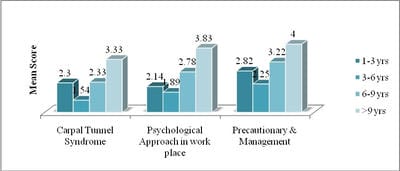Computer Professionals and their Health issues and Managements
Sudharshini S.1, Anantha Raman V.V.2*, Mathew Arumai M.< sup>3
DOI: https://doi.org/10.17511/ijphr.2018.i3.03
1 Sudharshini S., Assistant Professor, Community Medicine Department, Madras Medical College, Chennai, Tamil Nadu, India.
2* Anantha Raman V.V., Associate Professor, Community Medicine Department, SRM Medical College and Research Centre, Chennai, Tamil Nadu, India.
3 Mathew Arumai M., Medical Social Worker, Community Medicine Department, SRM Medical College and Research Centre, Chennai, Tamil Nadu, India.
Background: The professionals using computers for more than four hours a day are susceptible to develop problems like computer vision syndrome (CVS), eye strain, shoulder problems, Musculoskeletal disorder, Carpal tunnel syndrome, stress, and neck and shoulder problem and back pain, etc. The current study has proposed to unearth these problems and associated factors with their working environment conditions and pave way for pursuing further researches in this area and bringing policy level changes to for their health betterment. Objectives: study has intended to explore the knowledge of health problems pertaining to exposure of computer work and their management among the computer professionals working in Chennai. Methods: Convenience sampling was adopted and implemented to collect data from 300 study subjects working in IT companies in Chennai, Tamilnadu, South India. Results: 71% of the study subjects had one or many problems like head ache, dry eyes, back ache, low back pain, etc., and 43% of them were aware of computer related problems. Conclusion: Over three-fourth of the study subjects have suffered one or more health problems due to the invariable use of comupters in their day-to-day work places and nearly half of them had an average knowledge on health issues. These problems need to beaddressed through application of measures.
Keywords: Computer Professionals, Computer Vision Syndrome, Exposure, Health Issues, Knowledge and Health Management
| Corresponding Author | How to Cite this Article | To Browse |
|---|---|---|
| , Associate Professor, Community Medicine Department, SRM Medical College and Research Centre, Chennai, Tamil Nadu, India. Email: |
Sudharshini S, Anantha Raman VV, Mathew Arumai M. Computer Professionals and their Health issues and Managements. Public Health Rev Int J Public Health Res. 2018;5(3):117-122. Available From https://publichealth.medresearch.in/index.php/ijphr/article/view/92 |


 ©
© 